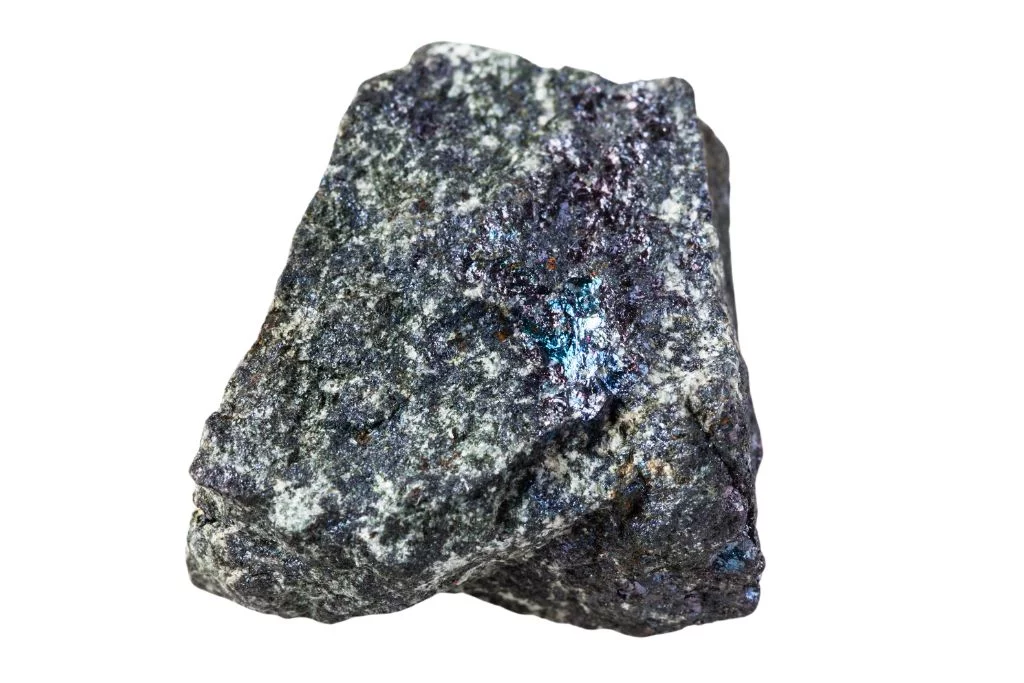Color and Luster of Bornite
Bornite, also known as peacock ore, is renowned for its striking and iridescent appearance. This copper iron sulfide mineral typically exhibits a metallic luster and displays a range of vibrant colors. Fresh surfaces of bornite often appear bronze or copper-red, but upon exposure to air, they quickly tarnish and develop a unique array of blue, purple, and reddish-brown hues. This remarkable color-changing property is what gives bornite its nickname “peacock ore” and makes it a favorite among mineral collectors.
Crystal Structure and Form
Bornite typically occurs in massive or granular form, rarely forming well-defined crystals. When crystals do form, they are usually small and exhibit a cubic or tetrahedral structure. The mineral often appears as irregular masses or as intergrown aggregates with other copper-bearing minerals. Bornite’s crystal system is orthorhombic, but it commonly occurs in pseudocubic forms due to twinning.
Physical Characteristics
Bornite has a Mohs hardness of 3 to 3.5, making it relatively soft compared to many other minerals. It has a specific gravity ranging from 4.9 to 5.3, indicating its high density. When scratched or powdered, bornite produces a grayish-black streak. The mineral is opaque and brittle, often breaking with an uneven to subconchoidal fracture. These physical properties, combined with its distinctive coloration, make bornite easily identifiable in the field.
Unique Features and Notable Aspects
One of the most distinctive features of bornite is its propensity for rapid tarnishing. This characteristic not only creates its famous peacock-like colors but also makes each specimen unique, as the tarnish patterns can vary significantly. Additionally, bornite often occurs in association with other copper minerals such as chalcopyrite, creating striking visual contrasts in rock specimens. The mineral’s ability to form beautiful intergrowths and its role as an important ore of copper further enhance its appeal to both collectors and geologists alike.
Historical and Cultural Significance of Bornite
Bornite, also known as peacock ore due to its iridescent colors, has been prized by various cultures throughout history. Ancient civilizations like the Egyptians and Romans valued this copper iron sulfide mineral for its unique appearance and believed it possessed mystical properties. Indigenous peoples in North and South America incorporated bornite into their spiritual practices and used it for decorative purposes.
Metaphysical Associations
In the realm of crystal healing and metaphysics, bornite is associated with balance, harmony, and personal growth. It is believed to enhance intuition and psychic abilities, making it popular among those who practice meditation and energy work. Bornite is thought to promote a positive outlook on life and help individuals overcome feelings of stagnation or uncertainty.
Common Uses and Benefits
While bornite is primarily used as a copper ore in industrial applications, it has gained popularity in alternative healing practices. Crystal enthusiasts use bornite in various ways, including carrying it as a pocket stone, placing it in living spaces, or incorporating it into jewelry. Some believe that bornite can help alleviate stress, boost creativity, and improve communication skills. In meditation, it is often used to facilitate spiritual growth and enhance one’s connection to higher realms of consciousness.
Modern Applications
Today, bornite continues to be valued in both practical and spiritual contexts. Its use in copper production remains significant, while its popularity in the metaphysical community has grown. Some modern jewelry designers incorporate bornite into their creations, capitalizing on its unique coloration and perceived energetic properties. Additionally, bornite specimens are sought after by mineral collectors and museums for their scientific and aesthetic value.

